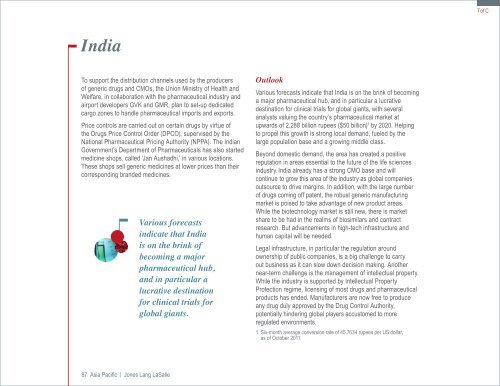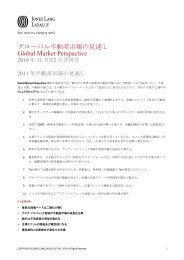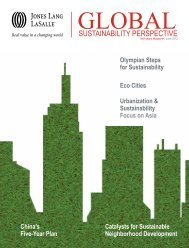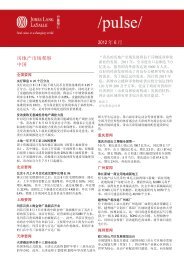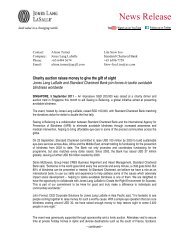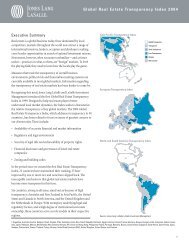Global Life Sciences Cluster Report 2011 - Jones Lang LaSalle
Global Life Sciences Cluster Report 2011 - Jones Lang LaSalle
Global Life Sciences Cluster Report 2011 - Jones Lang LaSalle
You also want an ePaper? Increase the reach of your titles
YUMPU automatically turns print PDFs into web optimized ePapers that Google loves.
India<br />
To support the distribution channels used by the producers<br />
of generic drugs and CMOs, the Union Ministry of Health and<br />
Welfare, in collaboration with the pharmaceutical industry and<br />
airport developers GVK and GMR, plan to set-up dedicated<br />
cargo zones to handle pharmaceutical imports and exports.<br />
Price controls are carried out on certain drugs by virtue of<br />
the Drugs Price Control Order (DPCO), supervised by the<br />
National Pharmaceutical Pricing Authority (NPPA). The Indian<br />
Government’s Department of Pharmaceuticals has also started<br />
medicine shops, called ‘Jan Aushadhi,’ in various locations.<br />
These shops sell generic medicines at lower prices than their<br />
corresponding branded medicines.<br />
87 Asia Pacific | <strong>Jones</strong> <strong>Lang</strong> <strong>LaSalle</strong><br />
Various forecasts<br />
indicate that India<br />
is on the brink of<br />
becoming a major<br />
pharmaceutical hub,<br />
and in particular a<br />
lucrative destination<br />
for clinical trials for<br />
global giants.<br />
Outlook<br />
Various forecasts indicate that India is on the brink of becoming<br />
a major pharmaceutical hub, and in particular a lucrative<br />
destination for clinical trials for global giants, with several<br />
analysts valuing the country’s pharmaceutical market at<br />
upwards of 2,288 billion rupees ($50 billion) 1 by 2020. Helping<br />
to propel this growth is strong local demand, fueled by the<br />
large population base and a growing middle class.<br />
Beyond domestic demand, the area has created a positive<br />
reputation in areas essential to the future of the life sciences<br />
industry. India already has a strong CMO base and will<br />
continue to grow this area of the industry as global companies<br />
outsource to drive margins. In addition, with the large number<br />
of drugs coming off patent, the robust generic manufacturing<br />
market is poised to take advantage of new product areas.<br />
While the biotechnology market is still new, there is market<br />
share to be had in the realms of biosimilars and contract<br />
research. But advancements in high-tech infrastructure and<br />
human capital will be needed.<br />
Legal infrastructure, in particular the regulation around<br />
ownership of public companies, is a big challenge to carry<br />
out business as it can slow down decision making. Another<br />
near-term challenge is the management of intellectual property.<br />
While the industry is supported by Intellectual Property<br />
Protection regime, licensing of most drugs and pharmaceutical<br />
products has ended. Manufacturers are now free to produce<br />
any drug duly approved by the Drug Control Authority,<br />
potentially hindering global players accustomed to more<br />
regulated environments.<br />
1. Six-month average conversion rate of 45.7634 rupees per US dollar,<br />
as of October <strong>2011</strong>.<br />
Tof C


